Blog Archives
Remote Site / Edge Management
Increasing Demand At The Edge
A shift is occurring at the edge, with enterprises prioritizing network infrastructure at remote sites. As IoT deployments increase, organizations are becoming more reliant upon data generated outside of the traditional data center.
To meet constantly growing demands, organizations are adding more critical applications at the edge with market growth expected to reach $9 billion by 2024. As this occurs, enterprises must be able to match the resilience, scalability, and high-availability found in the data center with a smart solution.
To learn more about evolving needs at the edge, download our white paper!
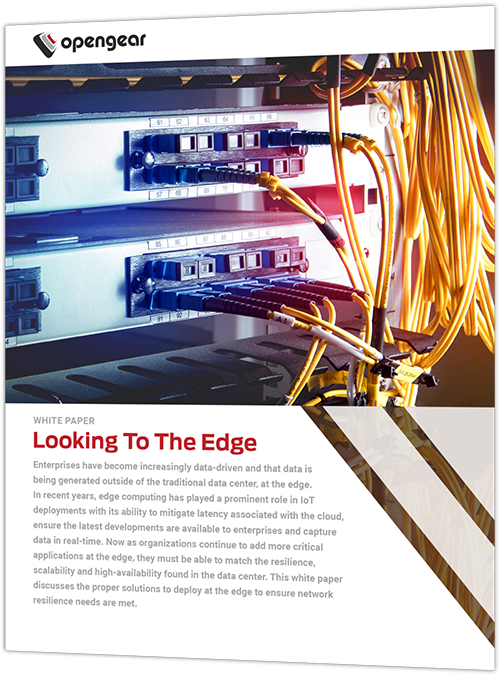
Network Resilience At Remote Sites
Smart Out-of-Band (Smart OOB™) paired with Failover to Cellular™ enables enterprises to ensure resilient backup connectivity to remote networks. Providing access to infrastructure during disruptions, organizations are able to ensure business continuity and uptime for critical applications.
Smart Out-of-Band adds intelligence to the edge, allowing enterprises to manage infrastructure at multiple sites. Designed to exceed the needs of IT and IoT resilience, it enables advanced capabilities for automatic responses for identification and remediation at the network edge.
Failover to Cellular ensures uninterrupted availability for remote networks with 4G LTE. Built on robust IP Passthrough technology, it is easily integrated into existing installs or can be rapidly deployed for instant-on connectivity for new networks and branch locations.
Lighthouse Enterprise serves as a central hub for remote sites, providing a clear view across the network. By reducing human error and guaranteeing repeatability, organizations reduce the chance of small network events becoming large scale disruptions.
Watch our video to learn more about Smart Out-of-Band.
Ensuring Fully Reliable Connectivity
Smart Out-of-Band and Failover to Cellular enable organizations to remotely remediate issues without interrupting business operations when the primary network is down.
Opengear worked with ePlus, a leading global provider of integrated technology services and solutions to ensure reliable connectivity at its remote sites. Opengear solutions have been deployed at its branch offices in the US for remote access, maintenance, and proactive monitoring.
Read our case study to learn how ePlus ensures uptime with Opengear.
Data Center Management
Evolving Data Center Demands
Data center environments continue to evolve, with their role and composition having changed significantly over the past two decades. From hyperscale data centers to colocations, whatever type of facility it is, enterprises expect speed, performance and efficiency.
The increase of new technologies such as the Internet of Things (IoT) are a major driver of growth in the data center market. The US Data Center market is projected to reach revenues of more than $60 billion by 2024, the high demand for facilities, now more than ever, require a smart solution for monitoring data center equipment.
To learn how resilient your data center is, download our ebook!
Always On Connectivity, From Anywhere
Smart Out-of-Band by Opengear raises infrastructure management to a new level. Extending beyond traditional out-of-band management solutions, it ensures efficient, secure access to data center infrastructure.
Streamlining remote management of network infrastructure, Smart Out-of-Band provides an alternative path to devices when the primary network is down. Automated intelligence ensures uptime for critical applications by enabling remote monitoring and control of the environment. Proactive identification allows enterprises to quickly remediate issues to ensure business continuity and minimize downtime costs.
Read our white paper to learn more about the benefits of Opengear smart solutions.
Keeping Data Centers Undefeated By Downtime
Smart Out-of-Band allows organizations across the globe to ensure resilient backup connectivity across devices in distributed data centers. Opengear’s console servers and infrastructure management solutions ensure network resilience to enable business continuity.
Opengear worked with i3D.Net, a leading provider of high-performance hosting and global infrastructure services, to help maintain its global operation. Requiring the network to be constantly up and running, they deployed Opengear solutions to ensure resilience to its routers all across the world.
Watch our video to learn how i3D.net experiences maximum uptime with Opengear.
Network Resilience
Keeping the Network Running, All the Time
Network resilience is the ability to provide and maintain an acceptable level of service in the face of faults that challenge normal operations. More than just improving uptime or building in redundancy, network resilience adds a layer of intelligence to the backbone of an enterprise – the IT infrastructure.
In an independent survey of IT Leaders, 49% said that Network Resilience was their #1 Priority.
To ensure maximum uptime, enterprises need a comprehensive solution designed to provide the highest levels of business continuity through proactive monitoring and remediation.
Learn more about ensuring network resilience by reading our latest blog.

Redundant Isn’t Resilient
Redundancy is an important part of the puzzle, and the reliability of a data center relies heavily on back-up generators, on-hand replacement hardware and secondary network connections. But while redundancy is a part of the resilience solution, it is not the only consideration. In smaller locations and satellite offices, it’s not cost effective to build in redundancy. And with no technical staff on site, the ability to monitor, manage and remediate the IT infrastructure remotely is a significant addition to a resilient solution.
Smart Out-of-Band management allows the network engineering team to securely access critical devices from a central location, to anticipate and remediate issues without sending a tech to site.
Discover the networking issues that are keeping senior IT decision-makers awake at night. Read the independent research commissioned by Opengear.
The Network Resilience Platform
The Opengear Network Resilience Platform is based on the presence and proximity of a Smart OOB Console Server at every IT location, centrally orchestrated through the Lighthouse Software.
The Network Resilience Platform provides secure remote access to your critical network resources through a separate management plane, with the ability to automate processes, such as securely deploying and provisioning equipment, and to access Remote IP devices at any edge location.
This platform is the Network Engineer’s Network. Secure remote access, via physical hardware at each location, providing an always-available independent network open only to the core network team; to be used on Day One, for everyday management, and during production network events.
Opengear’s Smart Out-of-Band technology, plus the use of open architecture NetOps automation tools (Docker support, Python runtime environment), provides secure access to console ports while also creating a robust management plane.
Schedule a Demo to learn more about our Network Resilience Platform
Failover to Cellular
Enable always-on availability
Opengear Failover to Cellular™ (F2C) provides continued internet connectivity for remote LANs and equipment over high-speed 4G LTE or 3G networks when the primary link is unavailable. Ensuring speed to keep the network running smoothly and link diversity for true WAN resilience, Failover to Cellular is built on robust IP Passthrough technology. This allows for easy integration into existing installs or can be rapidly deployed for instant-on connectivity for new networks and branch locations.
This feature is useful for an SD-WAN deployment. SD-WAN enables organizations to reduce costs and maintain secure network connections, however the high bandwidth internet connections, routers and constant firmware updates associated with this can introduce a single point of failure. If the network goes down during a deployment, Smart OOB™ and Failover to Cellular ensures secondary access to the routers to easily reflash or power cycle. NetOps staff are able to remotely get the network backup and running without an onsite visit.
READ CASE STUDY
Increase resilience and remediation
Failover to Cellular allows organizations to maintain connectivity and decrease disruption with ensured business continuity. Easily integrating with existing IT systems and network infrastructure, F2C restores WAN connectivity without manual intervention. Utilized with Smart Out-of-Band (Smart OOB), which is built into all Opengear devices, organizations are able to have remote access even when WAN and LAN networks are down. During an outage, in order to remediate the problem as quickly as possible, network engineers must have visibility of the whole network. Smart OOB provides engineers with full visibility to maximize uptime and reduce outages.
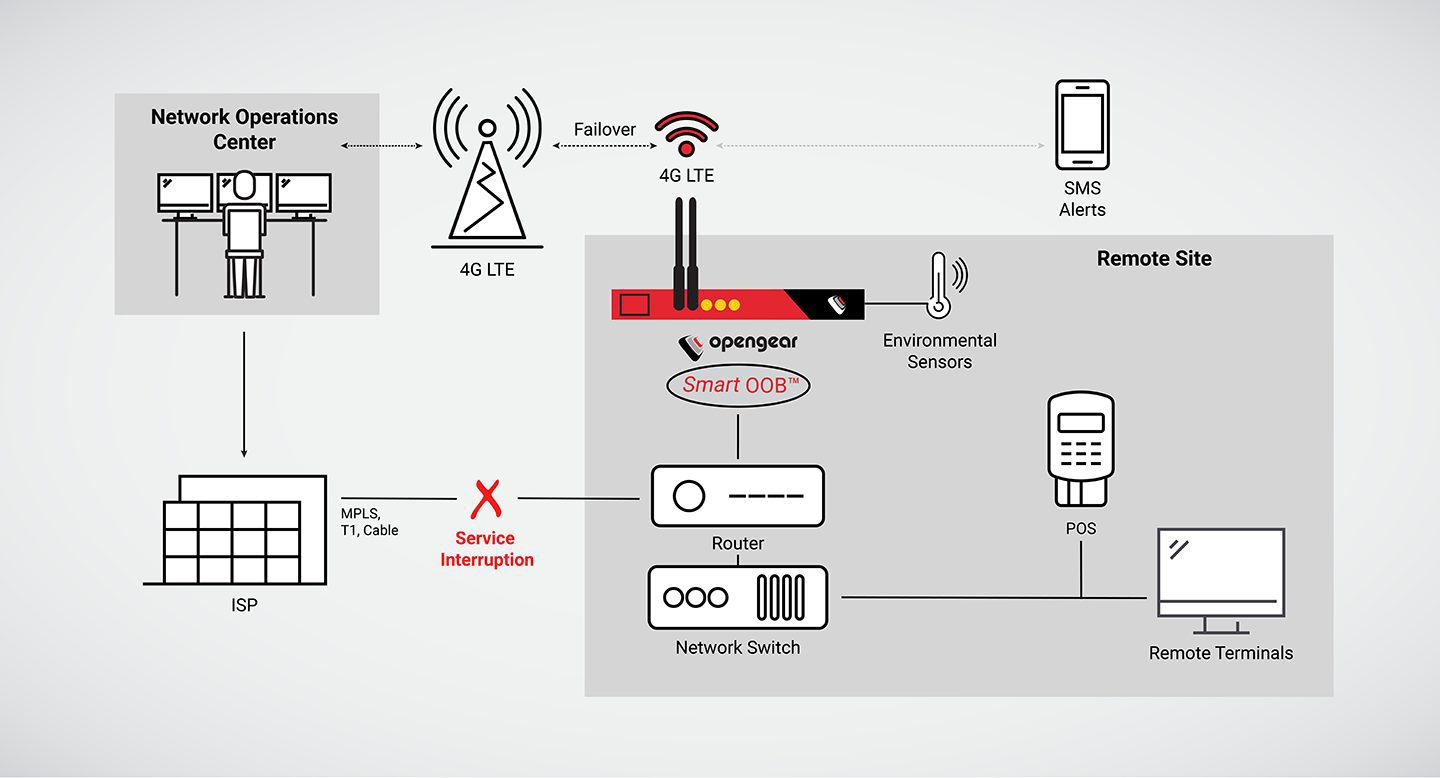
Remediate issues remotely
Distributed enterprises often times may experience disruption events that effect the primary network connection. Failover to Cellular built-in to Opengear devices, automatically activate a secondary connection to re-establish in and outbound network access. Once failover is enabled, Opengear devices are able to detect failures sending ICMP ping requests from the primary network interface to a primary and secondary probe address remotely. If these requests fail – the primary connection has been deemed as having also failed. When the primary connection has been restored, the devices automatically fail forward and resumes normal operation.
Zero Touch Provisioning (ZTP)
In hyperscale infrastructures, automation is the name of the game.
Network administrators tasked with deploying large scale IT infrastructure increasingly look to automate the deployment process. Traditional deployments require them to log into a single unit via CLI and configure all settings – and then rinse and repeat. This rinse and repeat model is error prone and mistakes could easily be made which could prevent out-of-band access during critical failures. By leveraging Zero Touch Provisioning (ZTP), administrators can now automate repetitive tasks, reduce human touch points, reduce errors and scale the deployment process to any size. Customizable scripting and file types allow ZTP to be flexible in any type of environment.
Opengear’s Zero Touch Deployment
- Cellular connectivity for Day One installations to prevent unnecessary delays
- Shared hardware reduces deployment costs
- Use a DHCP and file server to provision devices with configuration and firmware during initial boot
- Built-in ZTP for rapid and automated configuration deployment
- Adaptable for existing provisioning systems
Faster Deployment with Opengear
An Opengear customer in the media and communications industry was utilizing the standard deployment method on a new large data center with many rows of equipment. They utilized a DHCP server on a cart and ZTP to provision 4 devices at a time. The Network Admins then verified the setup and moved onto the next batch. Due to the scale of the deployment, this was inefficient and very costly with each set taking about 2 days. When they transitioned to Opengear’s solution, eliminating the need for manual setup of each individual device, the deployment time was reduced to 2 hours and with additional tweaks reduced that time to 20 minutes.

Sanity Check Your Network
Link Layer Discovery Protocol (LLDP) ensures the network is setup as it was designed. In a large and complex data center, it can be a tedious and time-consuming task to verify the installation, and an incorrect connection could cause issues down the road including network downtime and loss of revenue. LLDP will ensure the network topology is correct and that the connections between the devices are correctly installed. This automates the verification process instead of checking every port and every cable.
Network Labs
Simple Management for Complex Lab Networks
Network labs require always on connectivity, whether supporting device testing before shipment, validating firmware upgrades or developing new hardware. Housing equipment and software from a wide range of vendors along with a growing number of IoT devices, Smart Out-of-Band management provides an ease of configurability and automation for even the most complex network lab.
Device Testing
To ensure that customers receive fully functioning products, extensive testing is completed before shipment. Unrealistic for one operator to efficiently run these Devices Under Test through the QA process, advanced features of Opengear console servers remediates this issue ensuring speed and high reliability for always on access. Allowing up to 96 devices to be connected at once, programming enables it to simulate operator input through a series of standard tests. Alerts, pass/fails and input/outputs are available to the QA team for final verification. Cascading allows multiple Opengear console servers to be clustered with one unit acting as the master to thousands of serial ports. These lab networks can then test large batches of devices with minimal operator intervention which enables efficient, high density testing and leads to significant cost savings.
Remote testers can:
- Recover from error conditions
- Power cycle a locked up device
- Reboot and reconfigure different versions of software
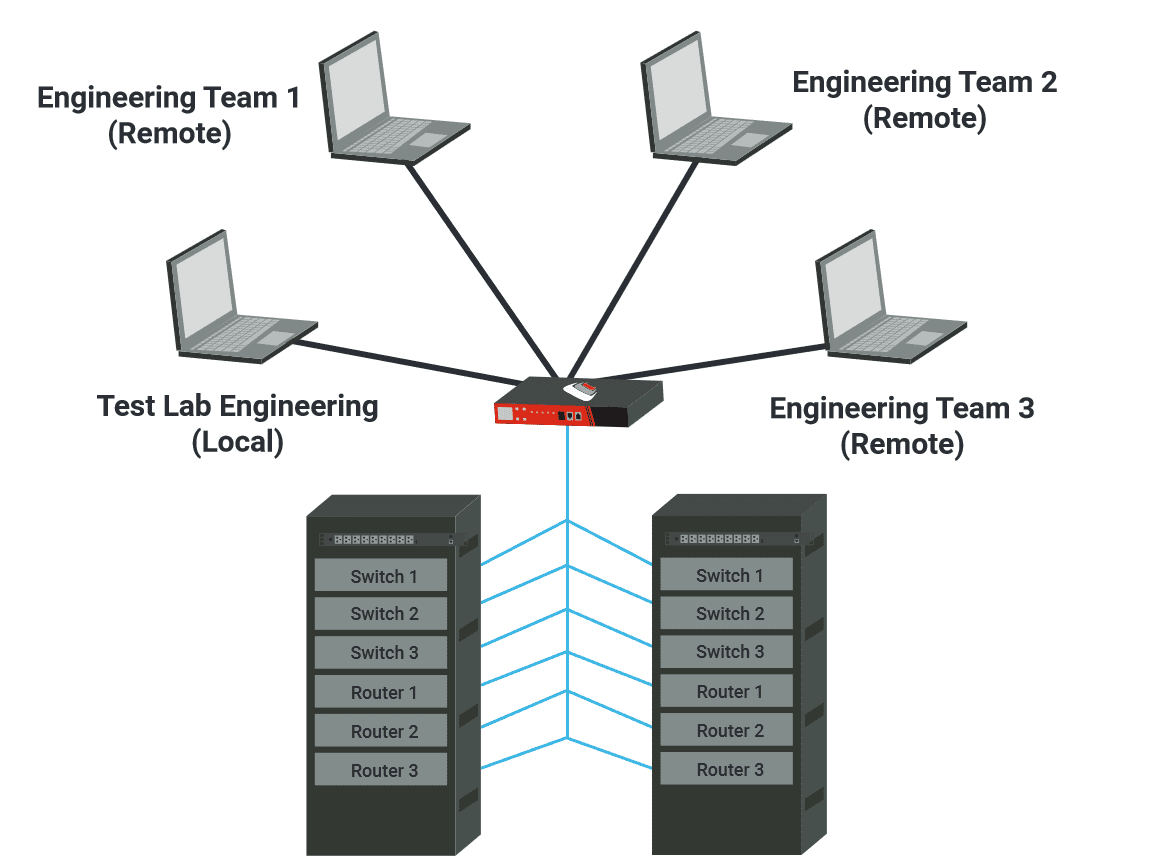
Firmware Validation
One of the most common applications for network labs is validating firmware upgrades and regression testing on various versions of operating systems. In these cases, any action or output must be logged and available for analysis – console errors, results, edge cases, random re-boots, last gasp trace and more. Opengear console servers support multiple versions of firmware with large embedded memory. There is also support for power cycling frozen test devices with preconfigured alerts while all actions and outputs are logged for analysis.
Connect to a wide range of devices with:
- USB
- Ethernet
- Serial ports

Provisioning New Lab Networks
Zero Touch Provisioning allows lab network engineers to set up new devices with automation to enable quick deployment and configuration in new, multi-vendor environments. Paired with Smart Out-of-Band engineers are able to manage and monitor remote equipment. High port densities allow for a wide variety of configurations while multiple firmware updates are enabled with embedded memory.

SD-WAN and Out-Of-Band
Creating Smarter Networks
SD-WAN provides organizations with secure network connections at a lower cost. Creating more agile Wide Area Networks (WANs) that are able to support the increasingly sophisticated distribution of network devices across multiple sites, the wide range of SD-WAN benefits have made it the standard in enterprise deployments.
These benefits include:
- Secure connection of standard broadband via a dynamic VPN tunnel
- Increased flexibility of new networks
- Reduced costs using commodity hardware
- Quick deployment of new networks
To provide these benefits however, the local routers in SD-WAN deployments have become more sophisticated which can pose challenges to traditional network management which expects constant network connectivity.
To learn more about smart solutions necessary for SD-WAN deployments, download our white paper today!
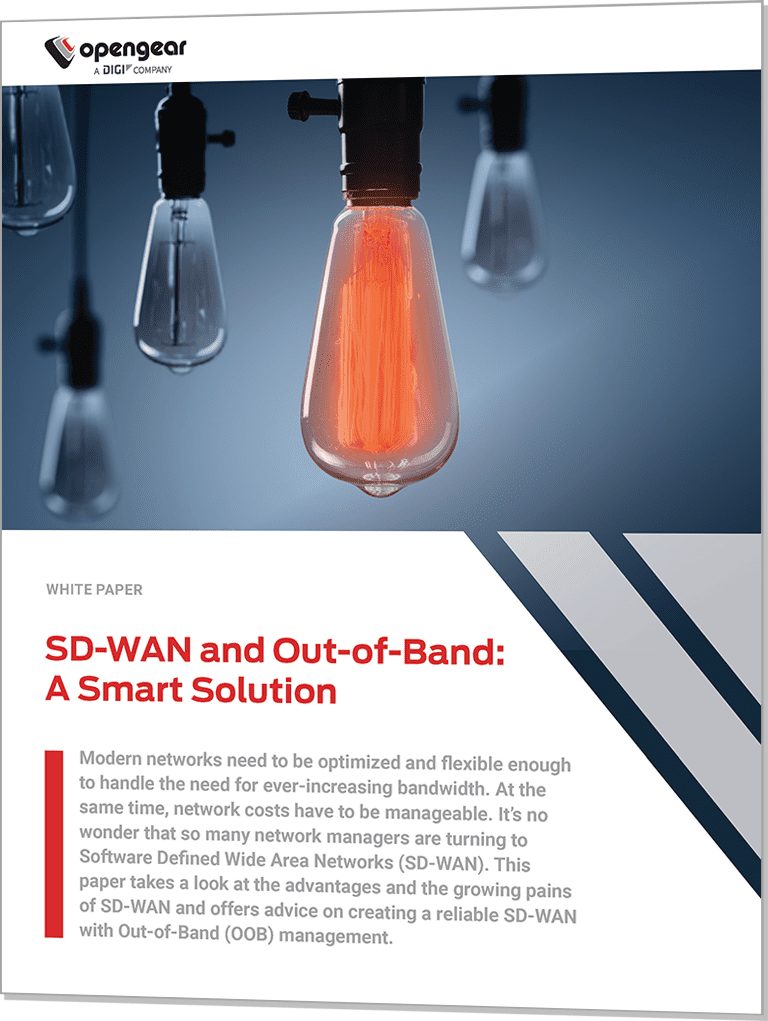
Understanding Potential SD-WAN Interrupters
The new flexibility enabled by SD-WAN brings with it a heightened need for remote engineers to manage on-site devices. The sophistication of the SD-WAN hardware introduces points of failure which without the proper solutions in place, become large scale disruptions.
These points of failure include:
Updates: Every time a firmware update is executed, there is a risk of a misconfiguration or error which can bring down the router.
Security: SD-WAN needs additional security offerings to protect the enterprise. The primary SD-WAN connection must be secure, and must be added to any other security solution being deployed.
Read our SD-WAN Solutions Overview Sheet to learn more about possible points of failure.
Ensuring Network Resilience with SD-WAN
SD-WAN is not a standalone solution. During the initial rollout or migration from the previous WAN, an organization’s network can be left unstable with frequent updates and glitches. Although there are many benefits to SD-WAN deployments, single points of failure can result with potential downtime. Smart Out-of-Band supports SD-WAN deployments, allowing engineers to access the network at all times.
Smart Out-of-Band is separate to the production network, providing engineers the ability to remotely monitor and manage all remote devices so that a disruption won’t affect the primary operation. Ensuring continuity and uptime using automated intelligence, Smart Out-of-Band paired with Failover to Cellular™ enables network resilience by providing always on access. Lighthouse Enterprise provides full network visibility to diagnose and remediate the issue if disruption occurs.
Learn more about the benefits of Smart Out-of-Band from Opengear for your next SD-WAN deployment!
NetOps Automation
NetOps for your Network
DevOps tools are increasingly applied to networking, creating a NetOps approach to building and maintaining a reliable infrastructure to support the virtualized world – a network that is both available and agile. One approach to introducing NetOps into an enterprise is to layer it into an existing solution, adding functionality and flexibility to a familiar component of your infrastructure.
A Smart Out-of-Band management network already provides presence and proximity to your critical devices, and so is well-placed to bring NetOps automation to your network. The ability to run standard NetOps tools, such as Docker, Ansible, and Python on a console server provides a new way to automate your operations at centralized and remote locations.

The OM Family of Console Servers
That solution now exists, in the new Opengear OM Family of Console Servers – Network Management appliances that combine the capabilities of a Smart OOB Console Server with the flexibility of NetOps Automation. They feature an x86 CPU to power automation tools, and a TMP2.0 chip for embedded security.
The compact OM1200 appliance is designed specifically for secure edge deployments, used in combination with Lighthouse Software, while the OM2200 appliance is configured for data centers and high density locations.
Integrated into Opengear’s Network Resilience Platform, they provide a separate, secure management plane which supports emerging requirements in Network Management and Automation.
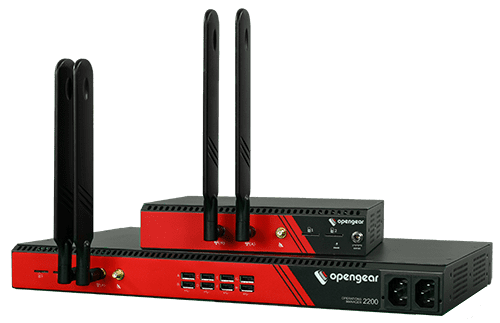
Out-of-Band Management
Resilience for Your Network
Out-of-Band management’s primary application is to provide secure, remote access to your critical resources even when the primary network is down. It offers presence and proximity to your distributed network, with a console server at every location, physically connected to routers, switches and key hardware. The addition of 4G-LTE provides a secure alternative access path, and Failover to CellularTM provides enough bandwidth for critical processes to continue to operate during an outage. When the network goes down, Out-of-Band keeps you running.
First Day, Worst Day, and Every Day
Is it smart to rely on the Production network to manage your network every day? With secure remote access to your devices via the console servers, Out-of-Band (OOB) management creates an always-on independent management plane, giving you reliable access to monitor and manage your IT infrastructure. Lock down the most critical functions on the Production network, and use the more secure OOB network to configure and manage your devices. Out-of-Band is the Network Engineer’s Network.
An investment in Out-of-Band Management is an investment that pays off every day.
- Secure Day One provisioning is now possible, using an OM2200 or OM1200 with embedded physical security, capable of running Docker containers and Python scripts.
- Everyday management and monitoring of your IT infrastructure is more secure and more resilient over the independent management plane, separate from the Production network
- Global cellular modules and centralized management software ensures access to your critical devices to fix the issue, when the primary network goes down
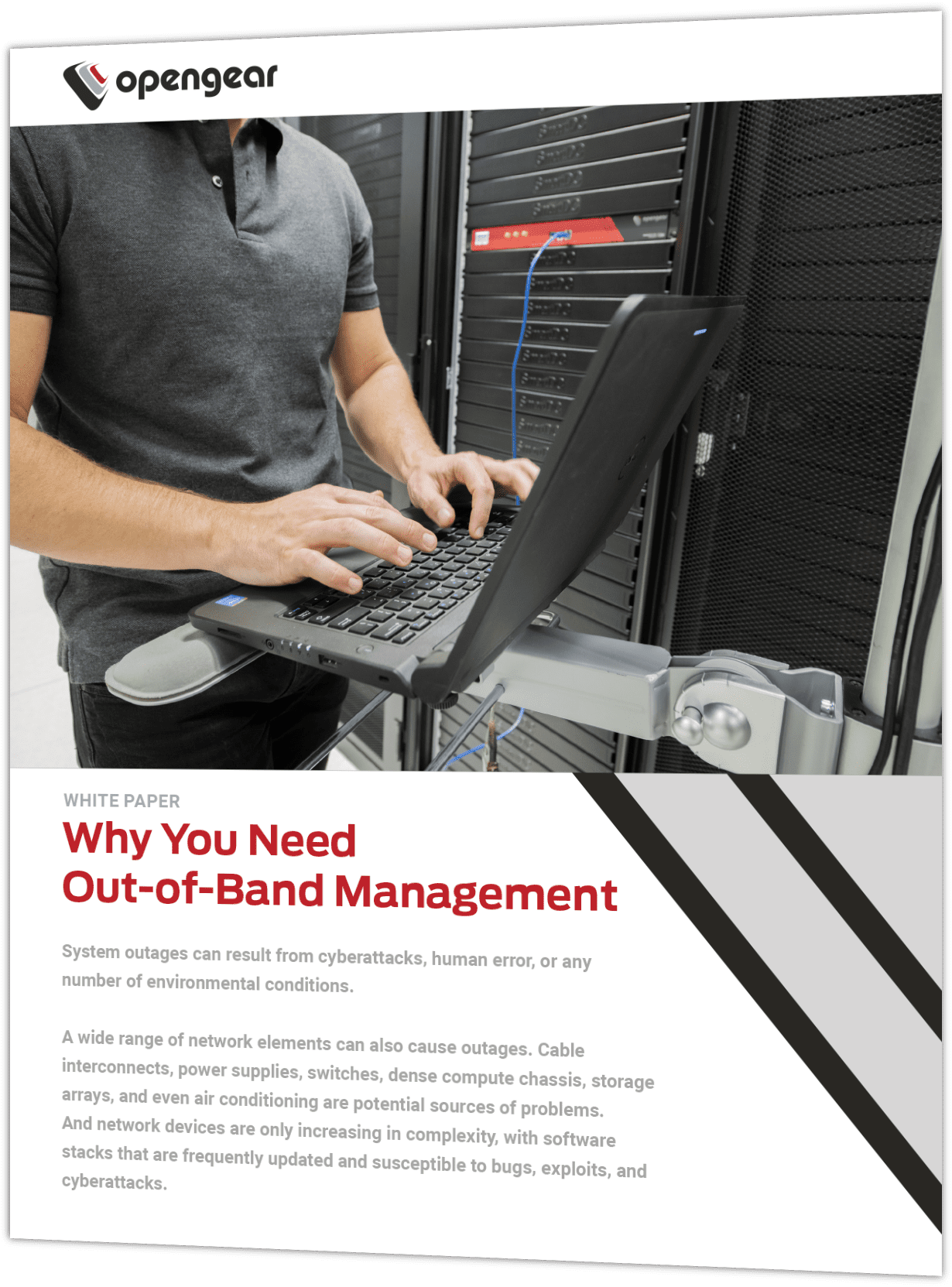
Resilience in the Data Center
Smart OOB allows organizations across the globe to ensure resilient backup connectivity, seamlessly access devices in remote data centers and reduce costs. Opengear’s console servers and infrastructure management solutions provide resilience and dependability to improve management functions.
Learn how cloud provider Secura Hosting utilized Smart OOB to reduce the time-consuming nature of dispatching engineers to its data center sites to make configuration changes and troubleshoot issues. Having deployed Smart Out-of-Band by Opengear, they’ve improved their management capabilities which led to a return on investment in just seven months
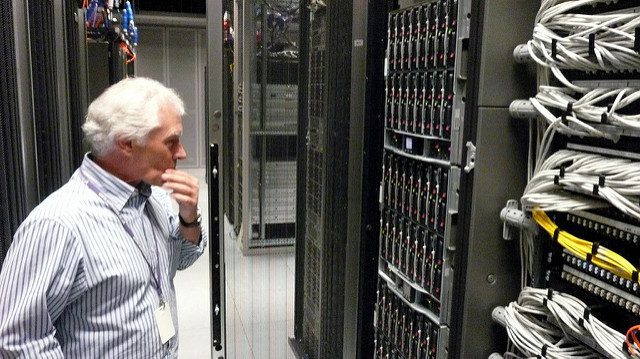
Case Study: Secura Cloud Hosting
An Edge Network as Reliable
as the Data Center
Your customers expect the same level of service, no matter where their data comes from. As computing moves closer to the edge of the network, the high uptime of a data center must be translated to small, remote locations. With no engineer on site, and with physical redundancy cost-prohibitive at each location, you need an alternative approach to resilience. Always-on access to an independent, secure management plane via a centralized software system provides a way to monitor and remediate issues at your edge locations without sending someone to site. Out-of-Band adds resilience to your network.
In an independent survey of 500 Global IT Leaders, 49% said that Network Resilience was their #1 Priority.

Hyperscale
Ensuring scalability and speed
Hyperscale data centers allow some of the largest technology organizations in the world, like Google, Facebook and Amazon, to maintain reliability and speed.
Hyperscale refers to the architecture of a data center and its ability to scale in response to increasing demand. This involves increasing memory, storage resources and infrastructure. The goal of scaling is to not only continue to build a system, but to do it big and fast. These massive systems are constantly rolling out new features. Because of this growth providers are prioritizing connectivity and availability – for this, they need a highly reliable solution.
Detecting and remediating remotely
Hyperscale data centers house thousands of devices and although their modular design allows operators to easily add resources as needed, their sheer size creates network visibility challenges. Constantly growing, operators are running into challenges that are causing outages and downtime. An alternative path to devices located at remote sites, Smart Out-of-Band (Smart OOB™) allows hyperscale providers to maintain connectivity if this occurs. Operators are able to securely monitor and access all devices without impacting normal operations to ensure business continuity.
When an error occurs, locating the exact router that is experiencing an issue can take hours or days without the right solution. Using Smart OOB operators are able to automatically find where an error has occurred and if it can be remediated or needs to be replaced to ensure business continuity.
Automating the deployment process
Zero Touch Provisioning allows hyperscale providers deploying large scale IT infrastructure to automate the process – repetitive tasks are reduced, human touch points are decreased and errors are lessened. Customizable scripting and files allow ZTP to be flexible in any environment. It allows hyperscale providers to remove the human factor and enable mass provisioning through the rack.
Zero Touch Deployment from Opengear:
- Ensures adaptability for existing provisioning systems
- Prevents unnecessary delays by ensuring cellular connectivity for Day One installations
- Verifies network topology to quickly troubleshoot and remediate issues using Link Layer Discovery Protocol (LLDP)
- Reduces deployment costs with shared hardware
Simplifying secure deployments
The Network Resilience Platform allows providers to provision new networks remotely and securely. Only requiring “smart hands” to rack, stack and cable the infrastructure, initial configuration tasks can be completed onsite, even when there is no existing WAN or LAN in place.
5G AND OOB
The next generation of wireless technology is here. 5G will enhance connectivity across all platforms, providing more efficient, faster and better signal strength which opens doors for new possibilities across cellular networks. It is predicted that by 2024 more than 1.5 billion devices will be connected to 5G.1 So how will 5G enhance your cellular connectivity?
Differentiating Between 4G and 5G
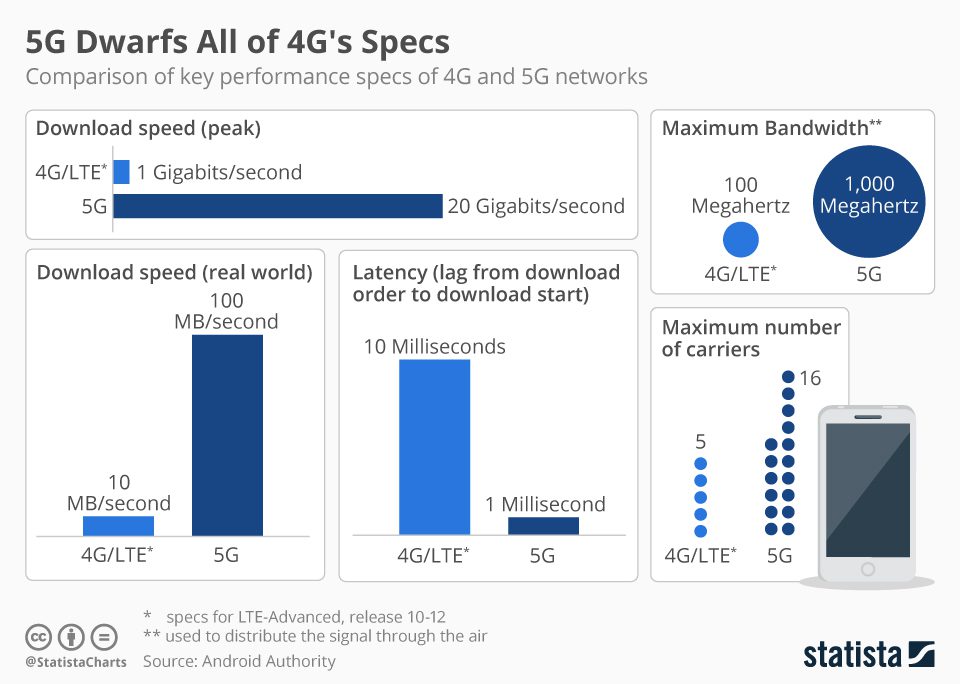 Ref: Statista
Ref: Statista5G will be a strong enabler in the expansion of the Internet of Things (IoT), given the speed and versatility it will bring to networks. 5G has a range of benefits when compared to 4G, based on its use of the 30 GHz to 300 GHz spectrum:
- Higher speeds: 5G peak speeds, at up to10 Gigabits/s, will potentially be ten times the speed of 4G. 2
- Lower Latency: 5G offers latency below 1ms, compared to a typical 4G performance of 10-50ms. 2
- Greater capacity: 5G networks will have capacity for a larger number of connected devices, by some estimates as much as one million devices per square kilometer3
5G is gradually being rolled out, so later iterations are expected to have even stronger capabilities.
It’s important to note that 5G, unlike previous iterations, is not expected to replace 4G. Many applications, such as standard mobile phone calls and low-data transactions, will still be carried on a 4G network, with 5G being applied primarily to large-compute and low-latency uses.
Given the higher frequency spectrum, 5G also requires a higher density of towers to cover a given area, meaning that rollout of 5G will initially be limited to metropolitan areas. It is also impacted more severely by physical barriers such as walls, trees, and even bad weather.
5G, IoT and the Edge
Compute locations are moving increasingly to the edge, driven by the growth of IoT and the desire to process and prioritize data closer to the collection point. Faster connections associated with 5G will support that migration as enterprises distribute their network power between Data Centers, Cloud Computing and the Edge.
The low latency and high speed of 5G particularly suit applications such as consumer VR/AR, AI, and autonomous vehicles, with high data density and rapid response requirements, enabling faster adoption of these technologies.
5G and Out-of-Band
Users expect the same level of uptime and response from their network, regardless of where that compute is located. But the reality of edge locations is that the type of system redundancy and staffing that is typical at data centers are not feasible at each location. Reliable, always-on access to the network devices, via out-of-band management, is a critical component of that network resilience.
As levels of automation continue to increase, enterprises will also have to extend the reach of their management and monitoring tools. Opengear solutions anticipate the current and future network needs of 5G.
Opengear smart solutions provide engineers at the Network Operations Center (NOC) with the ability to reach devices located at the edge. Lighthouse ensures access and visibility remotely, during critical failures while Smart Out-of-Band provides advanced troubleshooting to remediate issues that may arise at the network’s edge. The NetOps Automation platform provides additional functionality to streamline repetitive workflows such as secure provisioning and event management.
Deciding When to Adopt
Each organization has a core IT infrastructure and line of business applications. Constantly improving technologies provide an opportunity to help them operate more efficiently. Once the right technologies have been identified, enterprises must identify the right moment to get on board to ensure meaningful results.
For 5G specifically, determining the right time to act requires understanding the most immediate use cases for it within the enterprise. The first is fixed internet connectivity. Instead of using cable, satellite or copper wires/ADSL, edge locations could potentially use 5G to get fixed internet connectivity. Because this eliminates the need for burdensome physical cables and wires, 5G may provide an easier method for deployment.
For many enterprises, it is too early to fully embrace 5G. Unless there are already specific applications that are limited by speed/latency of existing connectivity technologies, the value of deploying it will not yet be realized. Instead, the focus, for now, should be on understanding the technology at a high level and identifying the use cases that are likely to benefit the business most so that they can be prioritized when 5G becomes readily available.
1 https://www.ericsson.com/assets/local/mobility-report/documents/2019/ericsson-mobility-report-june-2019.pdf
2 https://www.digitaltrends.com/mobile/5g-vs-4g/
3 https://www.androidauthority.com/what-is-5g-explained-944868/
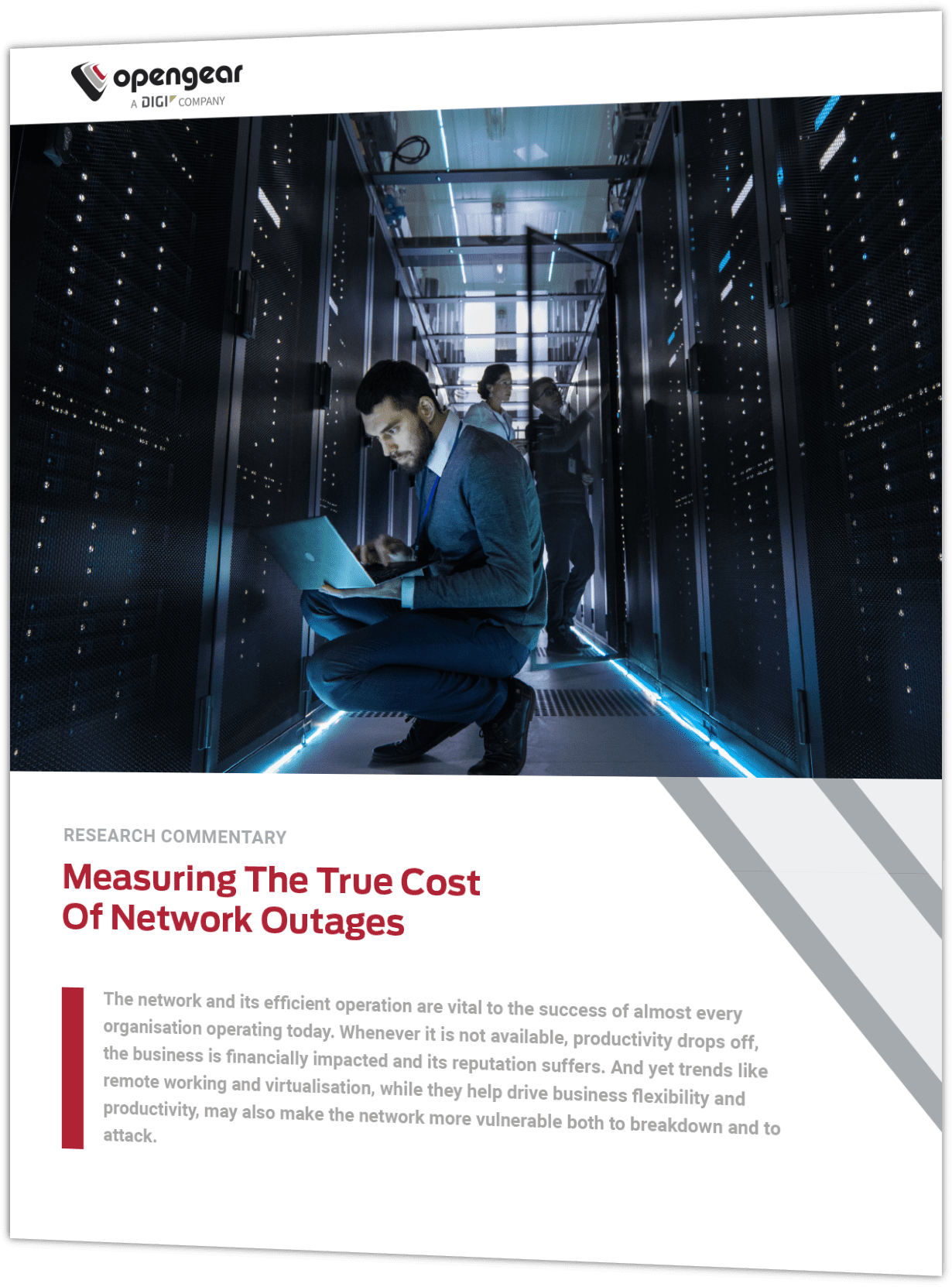
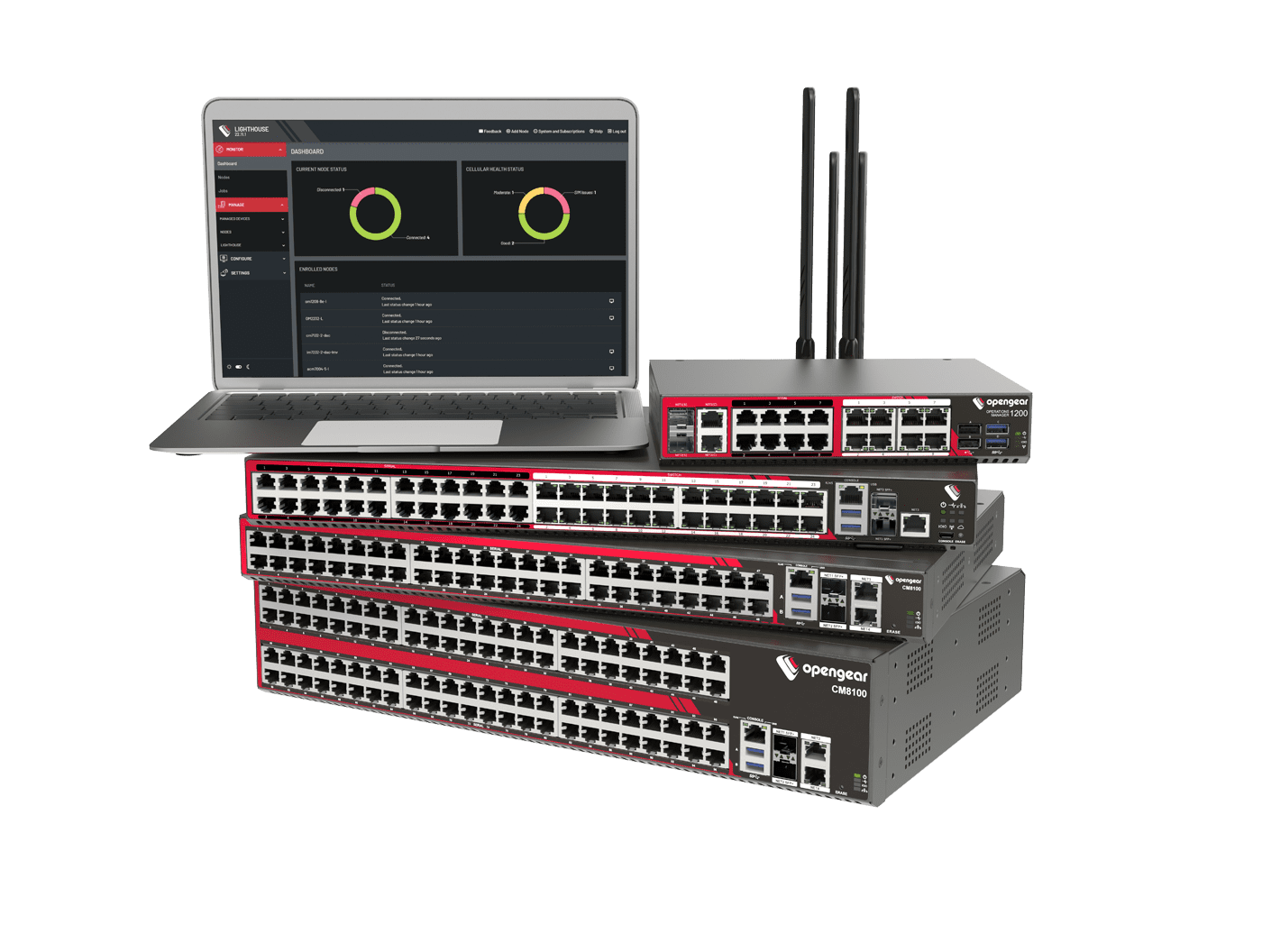


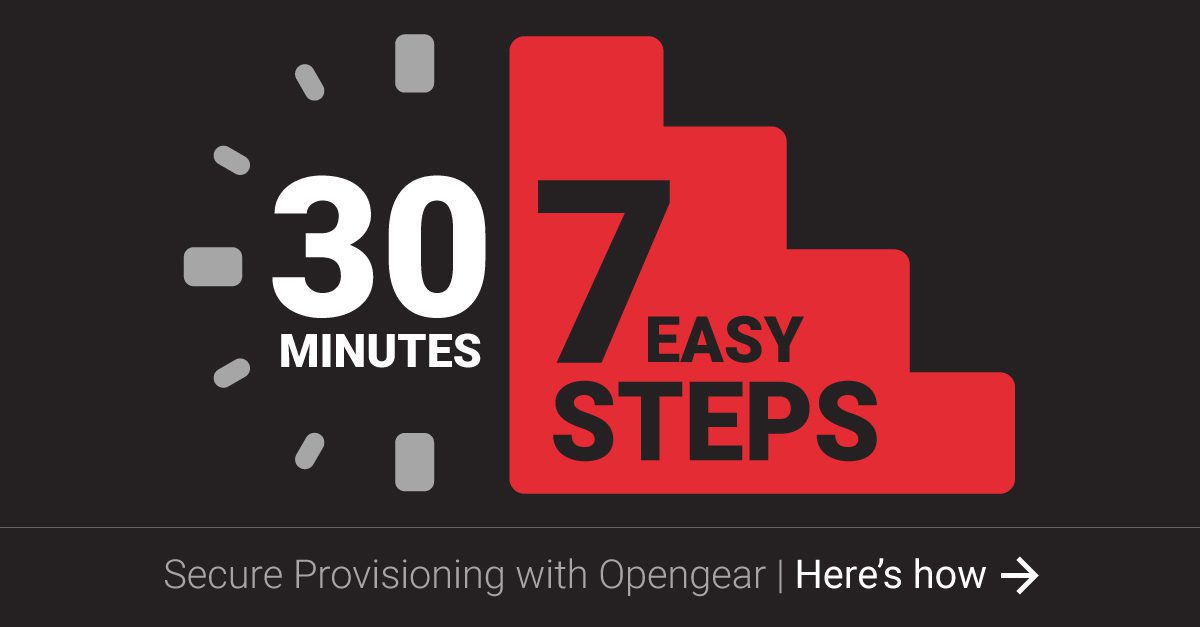
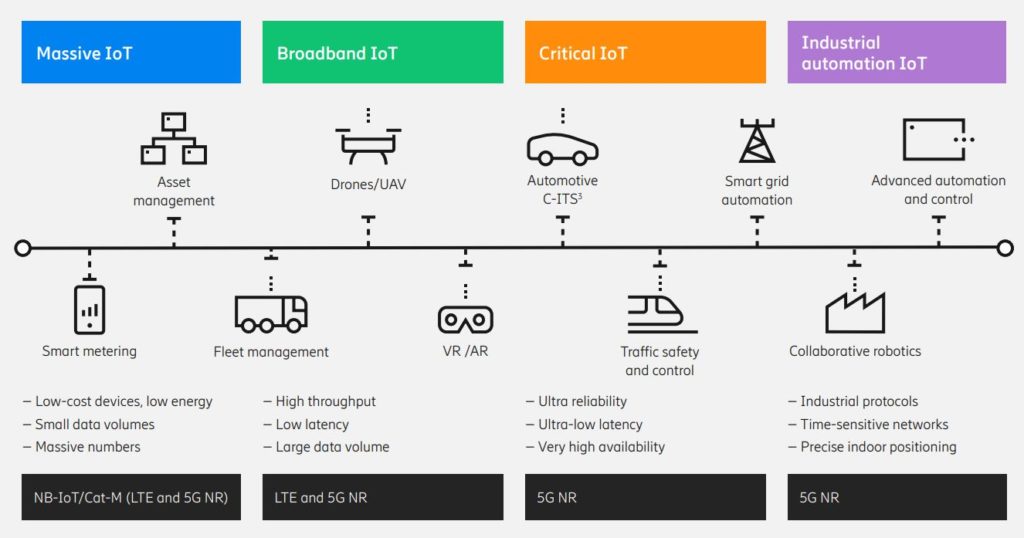 Cellular IoT use case segments
Cellular IoT use case segments